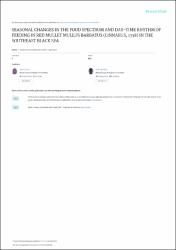Seasonal changes in the food spectrum and day-time rhythm of feeding in red mullet mullus barbatus (Linnaeus, 1758) in the southeast Black Sea
Citation
Onay, H. & Dalgıç, G. (2019). Seasonal changes in the food spectrum and day-time rhythm of feeding in red mullet Mullus Barbatus (Linnaeus, 1758) in the southeast Black Sea. Fresenius Environmental Bulletin, 28(4), 2671-2678.Abstract
The diet of the red mullet Mullus barbatus was studied in the southeast Black Sea region of Turkey during the autumn, winter, summer and spring. in one year, the stomach contents of 760 individuals of M. barbatus, a confirmed omnivorous fish species, were examined (April 2017 March 2018), in addition to those of 180 additional individuals examined within a 24-h period (28 April 2018). Among the 14 prey groups identified in the stomachs of red mullet, the predominant one was Bivalvia, followed by Nematoda, Polychaeta, Brachyura and Cumacea. Data analysis revealed significant differences in prey species composition between seasons (ANOSIM, R = 0.089, p < 0.001). Moreover, the prey groups that constituted the majority of the diet changed significantly with a season. SIMPER analysis revealed that the prey item contributing the most to the differences between seasons was Bivalvia, Microplastic was also found in the samples. Analysis of the daily rhythm diet variation in stomach contents allowed the identification of 8 prey groups, namely Bivalvia, Amphipoda and Cumacea. in 24 -hour examinations, feeding began in the first hours of the day, then showed an increase in the following hours and decreased after the evening. the results of this study could be used to describe the diversity of prey species and intraspecific food competition in the Black Sea.


















